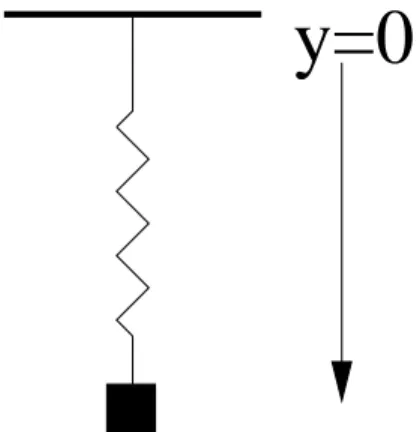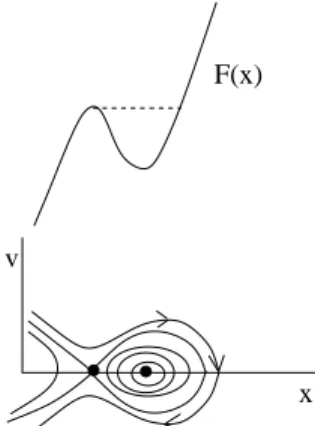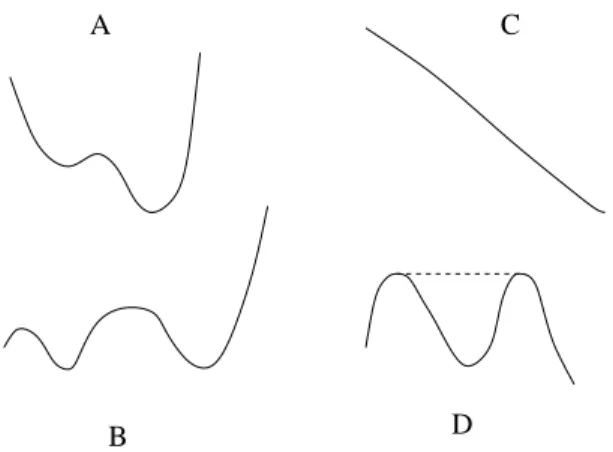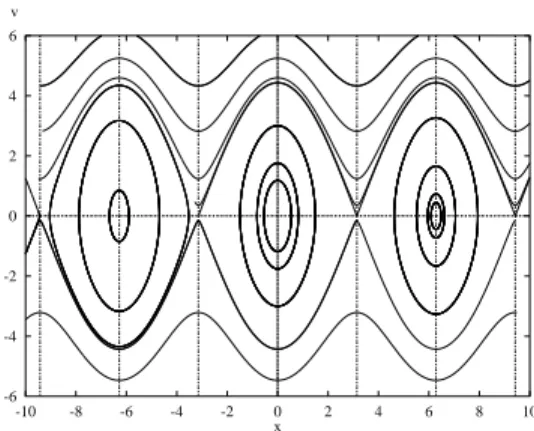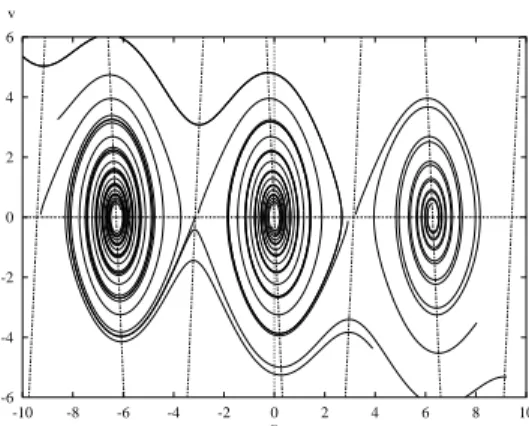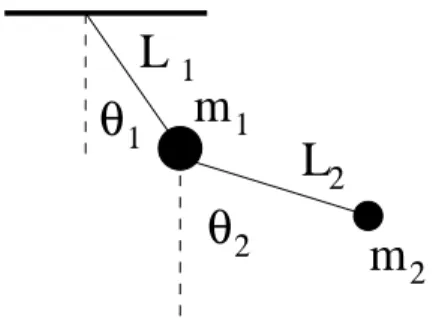y=0
Figure 1: The spring with gravity
1 The Euler Lagrange Equations
Many interesting models can be created from classical mechanics problems in which the simple motions of objects are studied. There are many ways in which you can create models from these simple systems. The most general is to use theEuler-Lagrange equations. To use these, you must compute the energy of the system you want to study. There are two kinds of energy: potential energy which is stored energy such as when a spring is compressed or an object is lifted up a height; andkinetic energywhich derives from the motion of the object.
1.1 Potential energy.
There are many sources of potential energy. I list a few of them:
Gravitational Energy. This is simplyEg=mghwheremis the mass,his the height, andg is gravity.
Inverse distance energy. Many phenomena have energy that depends of the inverse of the distance, Ei =K/r where K is a constant and r is a distance.
Spring energy. This is the energy held by compressing a spring or extending it. The simplest (Hooke’s law) spring has an energy, EH = 12K(l−l0)2 whereK is a constant andl0 is the rest length of the spring.
Chemical and electrical energy are other types that can be important in appli- cations, but almost all of the systems we study here rely on the above three examples.
For example, consider a spring with a mass hanging from it suspended from the ceiling. (See the figure). The potential energy due to gravity is−mgy and the energy stored by the spring is (K/2)(y−l0)2. The potential energy, P is
just the sum. The equilibrium position of the spring minimizes the energy, so
∂P
∂y =−mg+K(y−l0) = 0.
The second derivative is positive so this is indeed a minimum; we see that yeq=l0+mg/K.
1.2 Kinetic Energy.
In general, kinetic energy is a sum of terms of the form,mv2/2 wherev is the velocity. If things are in more than one dimension, then you must take all the component velocities. For the spring system above, the kinetic energy is just:
T =my˙2/2.
1.3 The Euler-Lagrange equations.
These equations tell us the equations for the dynamics. The dynamics satisfies:
d dt
∂(T−P)
∂v
= ∂(T−P)
∂x
wherev is each component velocity andx is each component position.
Let’s get the equations for our hanging spring. Herev= ˙y andx=y is the position. The potential energy is independent of the velocity and the kinetic energy is independent of the position, so this is quite easy. We see that:
d
dt(my) =˙ mg−K(y−l0) which we can rewrite as
¨
y =g−(K/m)(y−l0).
1.4 Examples
1.4.1 One-degree-of-freedom models.
Consider a single point mass in one dimension with potential energy,F(x) where xis the position. The kinetic energy is T =mx˙2/2 and the potential energy is P =F(x).Then, clearly:
m¨x=−f(x)≡ −∂F
∂x. (1)
Here f(x) is the force (recall, that this is the derivative of the energy with respect to distance.) We can write this as a system of two first order equations:
˙
x=v v˙ =−f(x)/m.
v
x F(x)
Figure 2: Energy and the phaseplane
Note that equilibria of these equations are v = 0 and the zeros of the force, f(¯x) = 0. Recalling that the force is the derivative of the energy, we see that ¯x are extrema of the potential energy. The stability is determined by linearizing:
A=
0 1
−mf0(¯x) 0
.
The fixed point is a saddle iff0(¯x)<0 since the determinant is justmf0(¯x).If f0(¯x) >0 then the eigenvalues are purely imaginary; since this is a nonlinear system, we cant say anything about stability. Or can we? As we will see below, imaginary eqigenvalues mean stability for these mechanical systems. Iff0(¯x)<0 this means that F00(¯x) < 0 andF0(¯x) = 0 so that the saddle-point equilibria representlocal maximaos the potential energy! Similarly, the neutrally stable fixed points are local minima!
Conservation of energy.
Consider the sum of the potential and kinetic energy:
E=T+P =mx˙2/2 +F(x). (2) If this does not change with time, then it must be constant. Differentiating this with respect totwe get:
dE
dt =mx˙x¨+f(x) ˙x= ˙x(m¨x+f(x)).
But from (1) we see that this last expression is zero, so ˙E = 0 and energy is conserved. This has wonderful consequences as far as our analysis of the phaseplane goes.
Phase planes for frictionless mechanical systems. Conservation of energy makes it very simple to plot the phaseplane of the system:
˙
x=v v˙=−f(x)/m.
A
B
C
D
Figure 3: Homework exercises
From (2) we know that
v2/2 +F(x) =E
whereE is just a constant. Thus, we can solve for v obtaining a whole family of trajectories:
v=±p
E−F(x).
Since you are unlikely to be very good at plotting, I will illustrate how easy it is with an example. The figure above shows a plot of the energy functionF(x) and the phaseplane underneath. Here is how to draw it:
1. PlotF(x). Draw the phaseplane below.
2. At each place where the derivative of F is zero (maxima and minima) draw a fixed point on thex−axis. If the point is a local minimum, then the fixed point is a center. Otherwise it is a saddle point.
3. For each maximum, draw a horizontal dashed line on the graph ofF(x) at the maximum until it hits another point onF(x).At each saddle point in the phase-plane, draw the corresponding orbit.
4. The easiest way to figure out orbits is to imagine a marble rolling on the potential functionF(x).
Here are some fun homework problems. For each sketched potential function, draw the phaseplane.
1.5 Examples
Now, we use the Euler-Lagrange equations to derive some examples and sketch the phase-plane.
θ mgh A
L L-x x
B l
Figure 4: The pendulum and the bead
The pendulum with massmand lengthl is shown in the above figure. The position of the bob is (x, y) where
x=lsinθ y=−lcosθ.
The potential energy is just P = −mglcosθ and the kinetic energy is T = (m/2)( ˙x2+ ˙y2). The definitions of x, y imply that T = (m/2)l2θ˙2. Thus the Euler-Lagrange equations are
d dt
∂(T−P)
∂θ˙
= ∂(T−P)
∂θ
sinceθ is the “position” and ˙θ is the “velocity”. This yields the equation for the pendulum:
d dt
ml2dθ
dt
=−mglsinθ (3)
If both the mass and the length of the pendulum are constant, then this sim- plifies to:
θ¨=−g l sinθ The total energy is just:
E= (m/2)l2θ˙2mgl(1−cosθ)
and this is conserved. (Note, I have added a constant to the energy so that it always is non-negative.) The potential energy is negative cosine and has local minima at even multiples ofπand maxima at odd multiples ofπ.Thus, centers alternate with saddles. Since each of the maxima have the same value, there are trajectories that connect each of the maxima. I show the phaseplane sketched with XPP. You could easily do this yourself.
There are two kinds of periodic soultions. The small ones around the rest state and the large ones corresponding to the pendulum swinging completely
-6 -4 -2 0 2 4 6 v
-10 -8 -6 -4 -2 0 2 4 6 8 10
x
Figure 5: The pendulum phaseplane
around. Note that these latter solutions always require a nonzero initial velocity while the small ones can be initiated just by pulling the pendulum up and releasing it.
Consider now a bead on a wire that is charged positively and atx= 0 and x=Lare two positively charged fixed particles. The potential is given by :
P =K0
x + KL
L−x
and the kinetic energy is (m/2) ˙x2.Thus, the Euler-Lagrange equations yield:
m¨x= K0
x2 − K1
(L−x)2.
The potential energy is just a well with infinitely steep walls atx= 0, L.Where is the minimum? It is where the dynamics is at equilibrium:
K0
x2 = K1 (L−x)2, that is,
L 2
2K0−2√ K0KL
K0−KL
Note that if K0 = KL, then the equilibrium point is L/2. Starting the bead away from rest leads to oscillations. SupposeK0=KL.Suppose we start with initial conditions ofv = 0, x =L/4.Then what is the maximum value that x can take? What is the maximum velocity? The total energy is conserved, so that
E0= (m/2)02+4K0
L +3K0
4L =K0(4/L+ 3L/4).
-6 -4 -2 0 2 4 6 v
-10 -8 -6 -4 -2 0 2 4 6 8 10
x
Figure 6: The pendulum with friction
All solutions to the equation must satisfy (m/2)v2+K0
x + K0
L−x =K0(4/L+ 3L/4).
The maximum value ofx occurs whenv= 0 so that we can solve this equation for x yielding the two roots, x =L/4 and x = 3L/4. Obviously, the latter is the maximum. The maximum velocity occurs when the potential is minimal.
(Recall that old ball rolling down a hill; when is the velocity maximal? At the bottom of the hill.) The maximum velocity is thus:
(m/2)v2=K0(4/L+ 3L/4)−2K0
L −2K0
L = 3K0L/4 orv=±p
3K0L/(2m).
1.6 Friction.
In all physical systems, there is friction. The simplest model for friction is a force that is negatively proportional to the velocity. Thus, the pendulum with friction is just
θ¨=−(g/l) sinθ−µθ˙ µ≥0.
The saddle points remain saddle points since the determinant is still negative.
The neutrally stable centers become either stable nodes or vortices. The phase- plane with friction is easy to draw since all trajectories eventually run down to equilibrium points.
1.7 Homework.
• Suppose that a particle of mass m at position x has a potential energy x3/3−2xWrite down the total energy. Use the Euler Lagrange equations to write down a differential equation. Sketch the phaseplane. Suppose
θ
1θ
2L
2m
1L
1m
2Figure 7: The double pendulum
x(0) = 1 and ˙x(0) = 0.What is the total energy of the solution? What is tyhe maximum velocity? the maximum value ofx? Sketch the phaseplane in the presence of friction.
• This one is more difficult. In the figure, I show you the double pendulum.
Derive the potential and kinetic energy for this in terms of the two angles, θ1, θ2 given the lengths and masses. Here is a hint. Let (x1, y1) be the coordinates of the first mass. Express these in terms of the angleθ1.This is just trigonometry and is like the single pendulum. Next, let (x2, y2) be the coordinates of the second mass. These depend on the angle θ2 and the coordinates (x1, y1).Now the kinetic energy is just (m1/2)( ˙x21+ ˙y12) + (m2/2)( ˙x22+ ˙y22) and the potential energy is−m1gy1−m2gy2.All of these can be expressed in terms of the anglesθ1,2.
